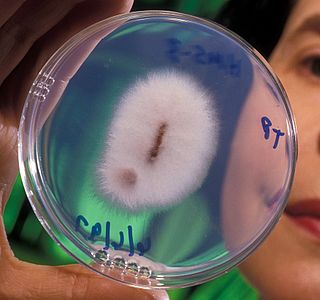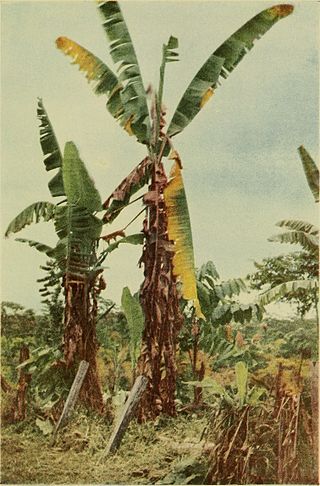Harold Corby Kistler is an American Adjunct Professor of biology and plant pathology at the University of Minnesota and a fellow of the American Phytopathological Society and the American Association for the Advancement of Science.
Harold Corby Kistler is an American Adjunct Professor of biology and plant pathology at the University of Minnesota and a fellow of the American Phytopathological Society and the American Association for the Advancement of Science.
Kistler obtained his B.S. degree in biology from Kent State University in 1975 and in 1983 got his Ph.D. in plant pathology from Cornell University. [1] He was a postdoc at the University of Wisconsin and in 1985 joined the Department of Plant Pathology at the University of Florida. In 1999 he became a research geneticist at the United States Department of Agriculture-Agricultural Research Service and then became adjunct professor at the University of Minnesota. Dr. Kistler is known for his studies on Fusarium species and is an editor of the journal Microbiology and associate editor of journals such as Phytopathology and Molecular Plant-Microbe Interactions . He also has been chair of various APS committees including the Genetics Committee, Mycology Committee, and the Physiology, Biochemistry, and Molecular Biology Committee. [2]
In 1998 Kistler along with Kerry O’Donnell, Elizabeth Cigelnik and Randy C. Ploetz had studied Panama disease of banana caused by F. oxysporum . [3] Two years later, he partnered with Kerry O’Donnell, Beth K. Tacke and Howard H. Casper to study scab of wheat and barley which was caused by F. graminearum . [4]
In 2007, Kistler led a team of scientists to sequence the genome of the fungal plant pathogen Fusarium graminearum , which causes Fusarium head blight disease on wheat and barley. This led to the discovery of highly polymorphic regions of the genome associated with pathogenic specialization. [5]

Fusarium ear blight (FEB), is a fungal disease of cereals, including wheat, barley, oats, rye and triticale. FEB is caused by a range of Fusarium fungi, which infects the heads of the crop, reducing grain yield. The disease is often associated with contamination by mycotoxins produced by the fungi already when the crop is growing in the field. The disease can cause severe economic losses as mycotoxin-contaminated grain cannot be sold for food or feed.

Fusarium oxysporum, an ascomycete fungus, comprises all the species, varieties and forms recognized by Wollenweber and Reinking within an infrageneric grouping called section Elegans. It is part of the family Nectriaceae.

Panama disease is a plant disease that infects banana plants. It is a wilting disease caused by the fungus Fusarium oxysporum f. sp. cubense (Foc). The pathogen is resistant to fungicides and its control is limited to phytosanitary measures.

Fusarium is a large genus of filamentous fungi, part of a group often referred to as hyphomycetes, widely distributed in soil and associated with plants. Most species are harmless saprobes, and are relatively abundant members of the soil microbial community. Some species produce mycotoxins in cereal crops that can affect human and animal health if they enter the food chain. The main toxins produced by these Fusarium species are fumonisins and trichothecenes. Despite most species apparently being harmless, some Fusarium species and subspecific groups are among the most important fungal pathogens of plants and animals.
Common root rot is a fungal disease of barley caused by Cochliobolus sativus, Fusarium culmorum and F. graminearum.

Fusarium culmorum is a fungal plant pathogen and the causal agent of seedling blight, foot rot, ear blight, stalk rot, common root rot and other diseases of cereals, grasses, and a wide variety of monocots and dicots. In coastal dunegrass, F. culmorum is a nonpathogenic symbiont conferring both salt and drought tolerance to the plant.

Gibberella zeae, also known by the name of its anamorph Fusarium graminearum, is a fungal plant pathogen which causes fusarium head blight (FHB), a devastating disease on wheat and barley. The pathogen is responsible for billions of dollars in economic losses worldwide each year. Infection causes shifts in the amino acid composition of wheat, resulting in shriveled kernels and contaminating the remaining grain with mycotoxins, mainly deoxynivalenol (DON), which inhibits protein biosynthesis; and zearalenone, an estrogenic mycotoxin. These toxins cause vomiting, liver damage, and reproductive defects in livestock, and are harmful to humans through contaminated food. Despite great efforts to find resistance genes against F. graminearum, no completely resistant variety is currently available. Research on the biology of F. graminearum is directed towards gaining insight into more details about the infection process and reveal weak spots in the life cycle of this pathogen to develop fungicides that can protect wheat from scab infection.
Crown rot of wheat is caused by the fungal pathogen Fusarium pseudograminearum. F. pseudograminearum is a member of the fungal phylum Ascomycota and is also known as Gibberella coronicola (teleomorph). It is a monoecious fungus, meaning it does not require another host other than wheat to complete its life cycle. Although F. pseudograminearum can produce both anamorphic and teleomorphic states, the teleomorph is usually not present for crown rot of wheat. This Fusarium species has, until recently, been considered to be the same as the species known as Fusarium graminearum due to many similar characteristics. One of the only differences between the two species is that F. pseudograminearum lacks its sexual stage on the wheat host.
Fusarium sporotrichioides is a fungal plant pathogen, one of various Fusarium species responsible for damaging crops, in particular causing a condition known as Fusarium head blight in wheat, consequently being of notable agricultural and economic importance. The species is ecologically widespread, being found across tropical and temperate regions, and is a significant producer of mycotoxins, particularly trichothecenes. Although mainly infecting crops, F. sporotrichioides-derived mycotoxins can have repercussions for human health in the case of the ingestion of infected cereals. One such example includes the outbreak of alimentary toxic aleukia (ATA) in Russia, of which F. sporotrichioides-infected crop was suspected to be the cause. Although current studies on F. sporotrichioides are somewhat limited in comparison to other species in the genus, Fusarium sporotrichioides has found several applications as a model system for experimentation in molecular biology.
Fusarium equiseti is a fungal species and plant pathogen on a varied range of crops.

Fusarium oxysporum f. sp. cubense is a fungal plant pathogen that causes Panama disease of banana, also known as fusarium wilt of banana. The fungi and the related disease are responsible for widespread pressure on banana growing regions, destroying the economic viability of several commercially important banana varieties.
Ruth Florence Allen (1879–1963) was an American botanist and plant pathologist and the first woman to earn her Ph.D. in botany from the University of Wisconsin. Her doctorate research focused on the reproduction and cell biology of ferns, particularly the phenomenon of apogamy. Later in her career, Allen shifted her focus to plant pathology. Her major contribution to the field of mycology was furthering the understanding of rust fungi, a group of economically important plant pathogens. Allen completed many studies on Puccinia graminis, once considered a catastrophically damaging disease-causing agent in cereal crops before the discovery of current management measures.

Thinopyrum obtusiflorum is a species of grass known by the common names tall wheatgrass, rush wheatgrass, and Eurasian quackgrass. It is native to Eurasia and it has been introduced to many other parts of the world, including much of the Americas and Australia.
Plant–fungus horizontal gene transfer is the movement of genetic material between individuals in the plant and fungus kingdoms. Horizontal gene transfer is universal in fungi, viruses, bacteria, and other eukaryotes. Horizontal gene transfer research often focuses on prokaryotes because of the abundant sequence data from diverse lineages, and because it is assumed not to play a significant role in eukaryotes.

Sophien Kamoun is a Tunisian biologist. He is a senior scientist at the Sainsbury Laboratory and professor of biology at the University of East Anglia (UEA). Kamoun is known for contributions to our understanding of plant diseases and plant immunity.
Robert James Cook is an American phytopathologist. He is best known for his work on soil-borne pathogens affecting wheat. He is the recipient of a Guggenheim Fellowship and the Wolf Prize in Agriculture and is a member of the National Academy of Sciences.

Amy Olymbia Charkowski is an American plant pathologist and Professor of Plant Pathology at Colorado State University. She was elected Fellow of the American Association for the Advancement of Science in 2020.
Robert Harry Stover was a Canadian-Honduran phytopathologist specializing in Musa crops and their fungal diseases.
Ralph Merrill Caldwell was an American plant breeder, mycologist, and plant pathologist. Through his work with the U.S. Department of Agriculture and Purdue University, he developed disease-resistant cultivars for a wide variety of plants, including widely-grown wheat cultivars.